Siberian Husky Puppies for Sale AKC Siberian Husky breeder, Each Siberian Husky Puppy is Guaranteed for Life! We believe in strong health and temperament for the perfect family dog who is great with kids, cats and other dogs. Specializing in MN, ND, IA, WI, SD, and the Midwest.
Purebred AKC Siberian Husky's since 1992
Purebred AKC Pomeranian's since 2022
Siberian Husky Coats and Colors
The Siberian Husky Rainbow of Colors
Unlike many breeds, the Siberian husky comes in an enormous range of coat colors and patterns. Below is an in depth look at the many coat colors of a Siberian Husky.
All Siberians are either Red or Black Based, the following colors are shades in which the genes effect to create the outcome of a dogs specific color.
Black & White Husky
Siberian coats can come is two shades of Black. These are: Jet Black, and Diluted Black (Sometimes referred to as Black, Gray, & White) The undercoat of a black & white Siberian may be white, charcoal, beige, or a mixture of these three. The top coat can be a range from jet black to a dilution, making the dog look almost gray. The dilution also gives the coat depth of color. A red tint is also allowed to the black. This red hue is quite rare, and develop when a black dog is exposed to the sun for long periods of time. When blowing the coat, a black Siberian can appear gray.


Gray & White Husky
The 3 Gray's
Siberian coats can come is three shades of gray. (Black based with dilution genes present resulting in grays) These are: Wolf Grey, Silver, and Medium/Dark Grey.
Wolf Grey is an allowance of the agouti gene which gives off a warm shade of gray with beige, tan, or red behind the ears, on the legs, and the back. Undercoat is beige. Pigment is restricted per individual hair. This coat gives off a rich color with lots of depth. Not to be confused to sable coated Siberians.

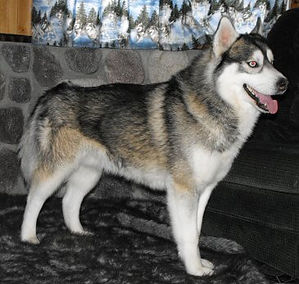
Silver is the complete opposite of a wolf gray. There is a complete restriction of the agouti gene. The coat comes off with a silvery or blue tone. There is no red, tan, or beige. The silver Siberians undercoat is white. Black can often tip the hair. When a dilution factor is present the shade of silver can become even more blue, with pigment being slate colored.

Medium/Dark Gray is the most common of the gray colorings. It allows red or tan tones, but not to the fullest depth. The richness of the red or tan is reduced but not completely cut out. Undercoat is a mixture of beige and silver.
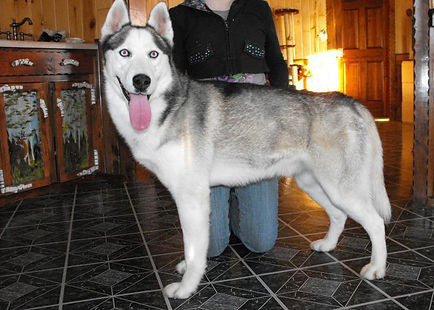

White Husky
White is perhaps the rarest coat color of Siberians. A white Siberian can have liver or black points(the color of the nose and skin around the eyes). This color, or lack thereof, is a result of the complete restriction of color pigments and extension of white over the dog's entire body. Undercoat is white.
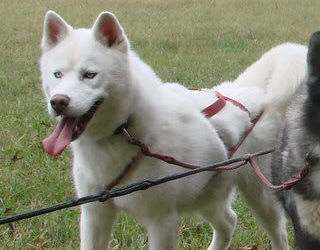
Agoutti & White Husky
(Wolf-like) colored Siberians are equally rare. It is also called "wild coloring". Agouti Siberians usually have special masks and markings. White markings are always cream. The mask is always dark, very heavy. (Dirty faced). Pigment extends far down on the dog's body. No dilution is present. Undercoat of agouti Siberians is charcoal. The outer coat can be a mixture of black, tan, red, or gray. The usual coloring is black on the root and tip of the hair, with red or tan in the middle. Points are black. Sometimes mistaken for sable or wolf gray. An agouti Siberian should look almost exactly like a wolf in coloring.
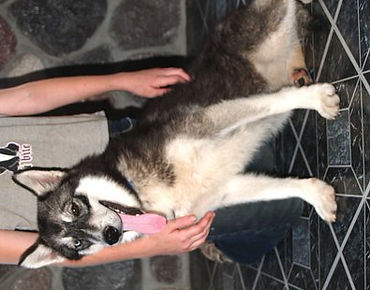
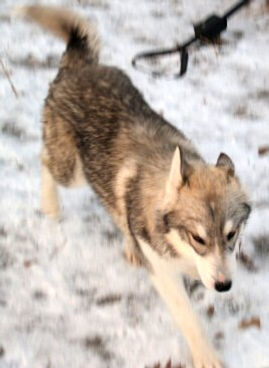
Red & White Husky
Copper/Red- Perhaps the most shade variation can be seen in the coats of red & white Siberians. (Red dogs with black points are considered Sable). Red & white Siberians always have liver points. Their undercoat can be copper, light red, or cream. Dilution factors can fade the coloring from dark to light across the body. Can be chocolate colored, to almost white.

"Dilute Red" is a light orange copper that allows more white than than red. The result is a red Siberian with a very light coat.

"Red" Siberian allows more red than tan. This brings out a bright color, and can sometimes give off an orange hue.

A "Dark Red" or "Copper" (also called chocolate red) Siberian has a tone with full depth of color. A brown or liver undercoat is present. This is the darkest possible red coloration.
Sable & White Husky
The Sable coated Siberian always has black points and black tipping on the fur. Undercoat is a shade of red, one of the three listed above, but never beige as in wolf-gray coats. Pigment is restricted with full allowance of color. Dilution factors never influence shade. Another very rare coat color. Some sables are born a wolf gray color, but the red tone deepens as time goes on. Sometimes called "black-nosed Reds".

Siberian Husky Coat Patterns
Pinto or Splash Coat Pattern
The pinto is not a color, but rather a pattern. A pinto Siberian can be any of the above colors, except white. The pinto Siberian has an excess of white, usually over the shoulders and front legs. Very Rare but can even have a half mask as pictured below.
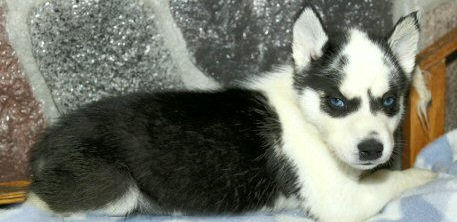


Piebald Pattern
Also a pattern the piebald is white with irregular patches of any other color. It is quite rare in Siberians. White is in excess of 30%. This breaks up the coloration of the Siberian, giving the Siberian spots and unique markings.


Siberian Husky Coat Types
Siberians are bred for a Standard Plush coat only however Siberians can carry a recessive gene for a wooly coat. Wooly coats are a fault in the show and working arenas.
Standard Coat
A Siberian Husky's coat is thicker than that of most other dog breeds, comprising two layers: a dense undercoat and a longer topcoat of short, straight guard hairs. It protects the dogs effectively against harsh arctic winters, but the coat also reflects heat in the summer. It is able to withstand temperatures as low as −50 to −60 °C (−58 to −76 °F).
Woolly Coats
Although the Siberian Husky has a double coat, the hair should not be excessively long. Long or woolly hair is a fault in a show or working Siberian. The long hair collects snow, possibly causing irritation when running. It is also a concern because it takes longer to dry, a dangerous fault in extremely cold weather. However they make great pets and are often sought after for pets due to their soft plush coat.

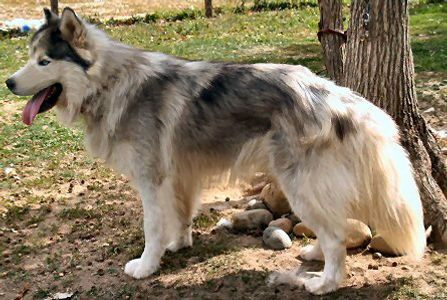

See more on colors, coats and patterns here
